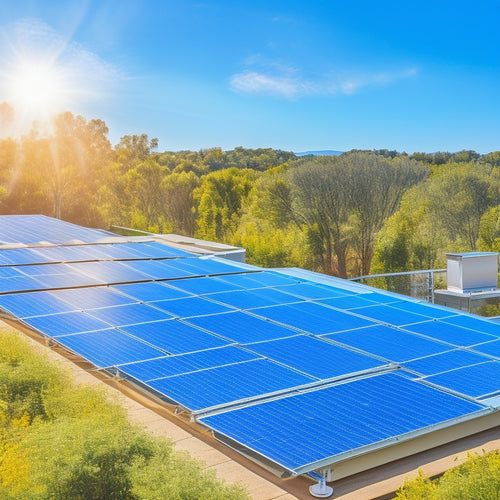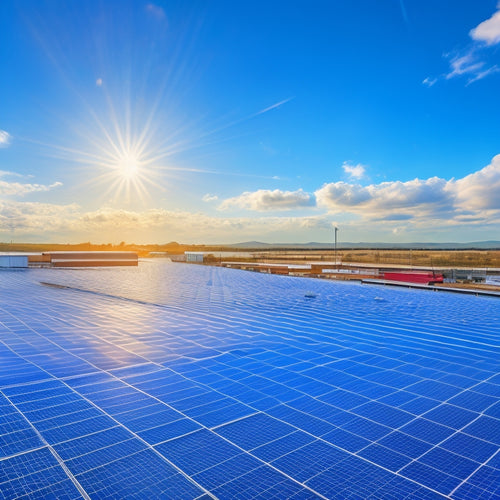
What Can You Cook in a Solar Oven
Share
You can cook various dishes in a solar oven, such as baked goods, stews, legumes, and even vegetables. These ovens reach temperatures between 200°F and 400°F using sunlight, which means you can bake bread in 1.5-2 hours or cook beans in 2-3 hours. This eco-friendly cooking method not only cuts energy costs but also preserves nutrients better than traditional methods. Additionally, the use of dark cookware helps improve heat absorption. By understanding different solar oven features, you'll optimize your cooking success and enjoy healthy meals, all while benefiting the environment. There's much more to investigate about solar cooking techniques.
At a Glance
- Solar ovens can bake bread, achieving perfect crust and texture with temperatures between 200°F and 400°F.
- Beans and legumes can be cooked thoroughly in 2-3 hours, maximizing flavor and nutrient retention.
- Vegetables retain their cellular structure and nutrients, making them healthier when steamed or roasted in a solar oven.
- Casseroles and stews benefit from slow cooking, allowing flavors to meld beautifully without the need for added fats.
- Desserts like brownies or cakes can be baked, providing a delicious treat while utilizing renewable solar energy.
Eco-Friendly Cooking Option
Using a solar oven presents a sustainable energy source that utilizes the sun's power for cooking.
By opting for this method, you greatly reduce your carbon footprint compared to traditional cooking methods that rely on fossil fuels.
Solar cookers provide a clean, efficient way to prepare meals without contributing to environmental degradation solar cooking benefits.
This eco-friendly approach not only benefits the environment but also promotes energy independence.
Sustainable Energy Source
Solar ovens represent an intriguing sustainable energy source that converts sunlight into a practical cooking method. By utilizing solar energy innovations, you can prepare meals without relying on conventional fuels, greatly reducing your energy consumption.
Solar cooking techniques employ reflectors to concentrate sunlight, generating heat that cooks food efficiently. These ovens can reach temperatures of up to 400°F, allowing you to bake, boil, or steam a variety of dishes. For instance, you can make hearty stews or even bake bread, all while drawing from a renewable resource. This not only promotes energy independence but also enables you to take control of your cooking methods.
Moreover, solar ovens are portable and can be used in various environments, from backyards to camping trips, making them a versatile choice for outdoor enthusiasts. As more people become aware of the benefits of solar cooking, the potential for widespread adoption grows.
Reduced Carbon Footprint
Cooking with a solar oven greatly reduces your carbon footprint, making it an eco-friendly option for meal preparation. By utilizing the sun's energy, you eliminate the need for fossil fuels, and thereby considerably lowering greenhouse gas emissions. This shift to solar cooking not only conserves energy but also minimizes your overall environmental impact.
Here's a quick comparison to illustrate the benefits of solar cooking:
| Aspect | Traditional Cooking |
|---|---|
| Energy Source | Fossil Fuels |
| Carbon Emissions | High |
| Operating Costs | Ongoing |
| Accessibility | Limited in some areas |
| Environmental Impact | Negative |
When you choose solar cooking, you're contributing to a sustainable future. Studies show that using a solar oven can reduce your household's carbon emissions by up to 1,000 pounds per year. This not only promotes ecological balance but also aligns with a lifestyle that values freedom from reliance on non-renewable resources. By making this simple change, you enable yourself to make a positive difference for the planet while enjoying healthy, delicious meals.
Saves Energy Costs Significantly
Using a solar oven can greatly reduce your electricity bills by utilizing the sun's energy for cooking.
This eco-friendly method not only cuts costs but also decreases your carbon footprint, aligning with sustainable living practices.
By utilizing compact solar cooking appliances, you can enjoy efficient cooking while maximizing solar energy absorption.
Reduced Electricity Bills
While many households grapple with rising energy costs, utilizing a solar oven can greatly alleviate those expenses. By tapping into the sun's power, you can markedly reduce your reliance on conventional electricity for cooking. This shift not only lowers your energy bills but also provides you with a sense of independence from fluctuating utility rates.
Engaging in a cost comparison reveals that solar ovens require minimal operational costs. Once you invest in the oven itself, which can range from budget-friendly to high-end models, your ongoing expenses are virtually nonexistent. This aligns perfectly with effective budgeting tips, as you can allocate funds previously spent on energy bills towards other essentials or savings.
Moreover, the solar oven's ability to cook meals without consuming electricity means you can enjoy substantial savings over time. Even if you only use it a few times a week, the cumulative effect will be noticeable on your monthly bills.
Embracing solar cooking allows you to reclaim control over your expenses, promoting not just financial freedom but a sustainable lifestyle. So, consider incorporating a solar oven into your culinary repertoire—your wallet will thank you.
Eco-Friendly Cooking Method
Solar ovens represent a revolutionary shift in eco-friendly cooking methods, greatly reducing energy costs and environmental impact. By utilizing the sun's energy, you can cook meals without relying on traditional fuel sources, which often contributes to high utility bills and carbon emissions. This shift not only benefits your wallet but also supports a sustainable lifestyle.
When you investigate solar recipes, you'll find a diverse range of dishes that can be prepared effortlessly. From baking bread to slow-cooking stews, the versatility of solar ovens allows you to create delicious meals while minimizing your carbon footprint. Additionally, using a solar oven aligns perfectly with outdoor gatherings, letting you enjoy nature while you cook.
Research indicates that solar cooking can reduce energy consumption by up to 87%, showcasing its potential as a viable alternative to conventional cooking methods. By adopting this eco-friendly approach, you're not just saving money; you're also promoting a cleaner planet.
Embracing solar cooking enables you to take control of your energy usage, nurturing a sense of freedom that comes with sustainable living. In a world increasingly focused on conservation, solar ovens offer a practical solution to meet your culinary needs responsibly.
Cooking Time Efficiency
When using a solar oven, you're likely to notice that cooking time can vary considerably based on the ideal temperature range achieved.
Proper battery water maintenance is crucial for solar-powered systems to guarantee consistent performance.
Research shows that meals can take longer to prepare in a solar oven compared to conventional ovens, particularly in cooler conditions.
Optimal Temperature Range
Achieving ideal cooking efficiency in a solar oven hinges on maintaining a perfect temperature range, typically between 200°F to 300°F (93°C to 149°C). This range offers a balance between slow cooking and adequate heat retention, ensuring your meals are cooked thoroughly without the risk of burning.
When temperatures fall below this range, you may struggle with temperature stability, leading to longer cooking times and uneven results.
At optimal temperatures, food undergoes the Maillard reaction, enhancing flavors and textures. For instance, simmering stews or baking bread becomes more effective within this range, as the heat promotes even cooking.
Additionally, solar ovens excel in heat retention, allowing you to utilize the sun's energy efficiently.
To maximize your solar oven's effectiveness, consider its placement throughout the day to catch direct sunlight and minimize heat loss.
Cooking Duration Comparison
Many factors influence cooking duration in a solar oven, making it essential to understand how time efficiency varies with different foods and conditions. The type of food you're cooking plays a considerable role in determining how long it takes. For example, denser items like potatoes can take longer due to their lower heat conductivity compared to lighter foods like vegetables.
Temperature variations are critical, too; solar ovens can reach between 200°F and 400°F, depending on the sun's intensity and your oven's design. Cooking techniques, such as preheating the oven or using dark cookware, can enhance efficiency. A well-prepared solar oven can reduce cooking time considerably, but you must be patient.
On average, you might find that cooking beans can take around 2 to 3 hours, while baking bread might require 1.5 to 2 hours. By understanding these subtleties, you can plan your meals better, ensuring ideal use of your solar oven.
Assess Size and Portability
When choosing a solar oven, you need to contemplate the size options available to guarantee it meets your cooking needs. A compact design can enhance portability, making it easier to transport for outdoor activities.
Additionally, assessing the energy efficiency of the solar oven can help you maximize its performance during cooking. Comprehending key features and considerations for battery backup systems will also provide perspectives on how to maintain a reliable energy source for your solar cooking needs.
Evaluating these features will help you select the best solar oven for your lifestyle.
Size Options Available
Choosing the right size for a solar oven can greatly impact your cooking experience and portability. When evaluating options, you'll find a range of sizes that cater to different needs. Compact designs are ideal for individuals or small families, allowing for easy transport and setup. On the other hand, large capacities suit group gatherings or extended camping trips, enabling you to cook more food at once.
Here's a breakdown of common size options:
| Size Type | Capacity | Portability |
|---|---|---|
| Compact | 1-2 people | High |
| Medium | 3-4 people | Moderate |
| Large | 5+ people | Low |
| Extra Large | 10+ people | Very Low |
Understanding these size options helps you align your cooking ambitions with practical use. If you're looking to welcome the freedom of outdoor cooking, selecting the right size will guarantee you can prepare meals efficiently, whether you're on a day hike or hosting a backyard barbecue. Keep these factors in mind to enhance your solar cooking experience.
Easy Transportation Features
Transporting your solar oven can be a seamless experience, especially if you consider its size and portability features. Many solar ovens are designed with a compact design, allowing you to easily fit them into your vehicle without sacrificing space for other essentials. When you're planning a camping trip or a picnic, this compactness becomes priceless.
Additionally, look for models that are travel friendly. Some solar ovens come with lightweight materials and foldable structures, making them simple to carry. If you're an outdoor enthusiast, you'll appreciate how these features enhance your freedom to cook anywhere, from beach outings to mountain hikes.
Mass is another critical factor. A solar oven that's under 10 pounds can be effortlessly handled, guaranteeing you won't feel burdened while setting up your cooking station.
Furthermore, many designs include convenient carrying handles that enhance portability even further.
In essence, when selecting a solar oven, prioritize those that offer a combination of compact design and travel-friendly elements. This way, you'll guarantee that your culinary escapades can happen anytime and anywhere, maximizing your time spent enjoying the great outdoors.
Healthier Cooking Method
Cooking in a solar oven can greatly enhance nutrient retention in your meals.
Studies show that lower cooking temperatures and reduced cooking times preserve vitamins and minerals better than traditional methods.
Nutrient Retention Benefits
When it comes to preserving nutrients, cooking with a solar oven offers notable advantages over conventional methods. The gentle heat of solar cooking minimizes the risk of nutrient loss, particularly during the cooking process.
Traditional cooking methods, such as boiling or frying, often expose food to high temperatures for extended periods, which can lead to significant nutrient degradation, especially in water-soluble vitamins like B and C.
In contrast, solar ovens operate at lower temperatures and use indirect heat, allowing for better nutrient preservation. Research indicates that cooking vegetables in a solar oven can enhance vitamin retention, as the slow cooking process helps maintain their cellular structure.
Additionally, solar cooking reduces the need for added fats or oils, which can further contribute to a healthier meal profile.
Frequently Asked Questions
Can I Use a Solar Oven on Cloudy Days?
Yes, you can use a solar oven on cloudy days. While it's less efficient, you can still employ effective solar cooking techniques, allowing you to prepare meals even when the sun isn't fully shining.
What Types of Pots and Pans Work Best in a Solar Oven?
For ideal heat retention in your solar oven, use dark, heavy pots with reflective surfaces. These materials absorb warmth efficiently, ensuring your meals cook evenly. Always prioritize quality materials to maximize your solar cooking experience.
How Do I Clean and Maintain My Solar Oven?
Cleaning your solar oven might seem unnecessary, but neglecting solar oven care can lead to poor performance. Use gentle cleaning techniques, like mild soap and water, to make certain it remains efficient and ready for your next culinary journey.
Are There Specific Recipes Designed for Solar Cooking?
Yes, there are specific recipes customized for solar cooking techniques. You'll find solar baking recipes for bread, cookies, and casseroles that optimize sunlight. Experimenting with these can enhance your outdoor cooking experience while embracing sustainable practices.
Can I Use a Solar Oven During Winter Months?
Yes, you can use a solar oven in winter. Accept solar cooking benefits by focusing on winter cooking tips, like maximizing sunlight exposure and using insulated containers to retain heat efficiently for ideal results.
Explore More
In a world where energy costs soar, a solar oven offers an invigorating alternative that not only saves you money but also promotes healthier cooking. While traditional ovens can heat your home—and your bills—solar ovens utilize the sun's energy, allowing you to prepare meals efficiently and sustainably. As you enjoy a perfectly roasted vegetable medley, remember that you're not just nourishing your body; you're also nurturing the planet. Adopt this eco-friendly method and change your cooking experience.
Related Posts
-

Top Eco-Friendly Camping Equipment for a Sustainable Adventure
When you're camping with the planet in mind, opt for eco-friendly gear like tents made from recycled materials and bi...
-

What Types of Solar Energy Devices Are Available
You'll find several types of solar energy devices available today, each customized to different energy needs. Photovo...
-

Commercial Solar Energy
As you consider powering your business with commercial solar energy, you'll uncover it offers a triple benefit: signi...


